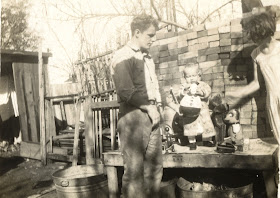Today I attended the third and final day of the
Texas State Genealogical Society (TSGS) annual conference, held this year at the
Riley Center in southwest Fort Worth. Today's program consisted of four sessions by Curt Witcher, manager of
The Genealogy Center of the Allen County (Indiana) Public Library (and also curator of the Rare and Fine Book Collection and their institutional archives).
Curt's first session was titled "An Ancestor's Death: A Time for Reaping," the point being that the potential for record generation is greatest at time of death. One can glean an enormous amount of information and clues from obituaries, death notices, family Bibles, funeral home records and guest books, remembrance cards and service programs, church death records, monument company records, burial permits, cemetery plat maps, and of course tombstones, wills, and probate records.
His second session was "Using Government Documents in Genealogical Research." With our small collection of federal and state documents under my jurisdiction at work, I was interested in this session for work-related reasons. Curt explained a little about the
SuDoc system for organizing federal records (
Texas uses a similar system for state documents), and discussed some indexes to them, both print and online. He showed numerous examples of genealogical information that can be found in these records that go beyond the recording of births, deaths, and marriages.
The third session was called "Finding the World with WorldCat,'
WorldCat.org being the largest bibliographic database in the world, online and free. Being a librarian, I thought I was pretty familiar with WorldCat, but Curt provided some great tips for searching (for instance, add "family" after your surname and put both words within one set of quotation marks). He also described a couple of features I did not know about (mostly because my use of WorldCat at work is primarily to look to see where the nearest library is that has the item I want that my library does not have, to determine if interlibrary loan is feasible).
One feature is the ability to create an account in WorldCat, and thus have a place to "store" your research record, create bibliographies and lists, and add notes, reviews, and tags to items. Another feature (a result of creating an account) is the ability to add notes to items that might help future researchers - for example, the table of contents of a book, whether or not it's indexed by name or geographically, etc. - which can be particularly helpful if such information is not available in the bibliographic record. Makes me want to do so with any unique item we might have in our genealogy collection at work (the local cemetery transcriptions come to mind - listing which cemeteries are covered in which volumes). Unfortunately, at the moment, any notes one adds aren't indexed and won't come up in WorldCat search results...maybe someday!
The final session of the day was called "Doing the History Eliminates the Mystery." The description in the syllabus pretty well sums it up: "an explanation and demonstration of how researching all the details of each ancestral family s well as the history surrounding the area can pay significant research dividends. Histories of geographic areas, ethnic and religious groups, migration patterns, and occupations can provide the genealogist with important data as well as pointers to other information."
Curt said to pretend you need to write a 1000-word historical essay on a particular ancestor. The first step is to focus on
all the details of this
single ancestor, by asking the journalist's who-what-when-where-why questions. The second step is to focus analytical attention on all the documents that support the details of that particular ancestor - and he provided quite a long list! He suggested setting up a matrix (pictured in the photo above) with local, state, and national along one axis, and published materials, unpublished materials, and government documents along another, and making sure you check locations that have each of these.
Step three is to evaluate the specific context in which you find your specific ancestor and ancestral family, followed by studying all the geographic histories of the target area. Curt noted that the old fire safety adage "stop, drop, and roll" can be applied to geographic targeting: stop your searching, drop to a specific geographic area where you found an ancestor, and "roll" around adjacent areas studying their history and looking for more relatives.
The final steps are to study all the ethnic histories that relate to your ancestor, and to check the neighbors, the topography, migration routes, and use timelines to place the ancestor/family in historical context. Curt's presentation was illustrated by two detailed examples from his own family trees, and lots of suggestions for sources.
All in all, this was another brain-busting day in a mind-exploding conference. I'm exhausted now, but I have lots of ideas on how I can improve access to genealogical and local history materials at work, and how to approach the brick walls in my own genealogical research.
© Amanda Pape - 2012 -
click here to e-mail me.
















